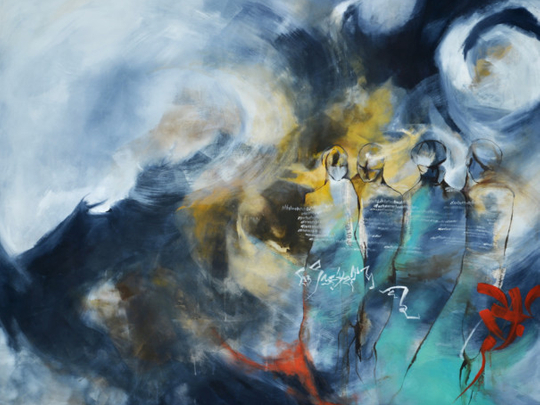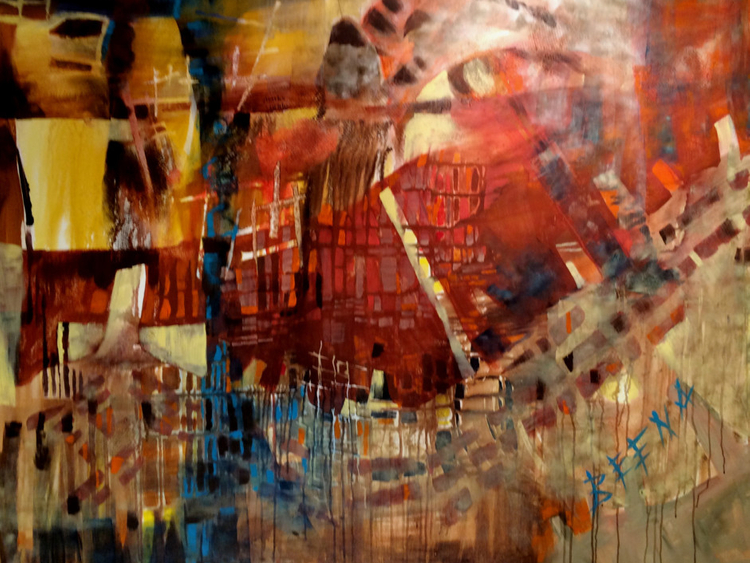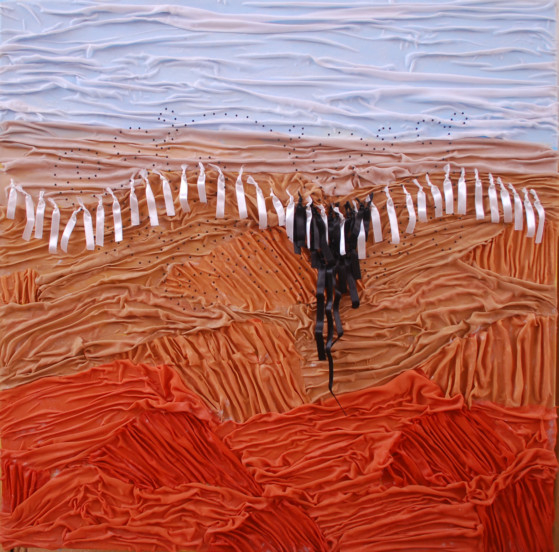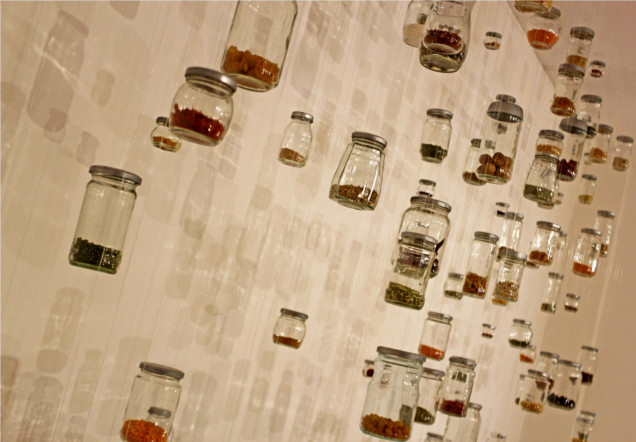
Dubai-based artists Jeff Scofield, Stephanie Neville, Beena Samuel and Diyali Sen Bhalla have always been interested in using recycled everyday objects and found materials to create art. But signing up for the Artist-in Residence programme at the Liwa Art Hub this summer gave them the opportunity to experiment with new materials, techniques and ideas.
During their stay at the tranquil Art Hub in the Liwa desert, the artists focused on “upcycling” various discarded materials and found objects to create interesting artworks that they are exhibiting in a group show of “Sustainable Art” at the Abu Dhabi Art Hub. Each artist has explored the theme of sustainability in their own personal way, and the artworks include mixed media paintings, sculptures and installations.
American artist Scofield, who is the art director of Gallery 76 at the Dubai International Art Centre (DIAC), is interested in exploring sustainable themes and the intrinsic nature of natural materials to create conceptual works that evoke the complexities and contradictions of modern life. He is excited about the new media he worked with during the residency.
“This was a great learning experience for me. I have never worked with sculpture before, but attempted it because Ahmad Al Yafei, founder of Art Hub, encouraged me to use the wide variety of salvaged materials stored at the venue. I used pieces of curved wood and copper wire to create a sculpture that evokes the graceful movements and rhythm of a dancer,” he says.
Scofield was also inspired by the vast variety of spices in the kitchen at the Art Hub to create an installation titled “City on the Spice Route”. The work features rows of glass jars, (which he also found at the venue), filled with different spices and suspended from the ceiling with fishing lines. The piece plays with colour, light, movement and forms while also evoking the history and culture of this region.
Neville, who is from South Africa, likes to work with embroidery, stitching and soft sculpture to convey feminine themes. “I have been looking for opportunities to do a residency, and it was wonderful to be able to do it right here in the UAE. I fell in the love with the place at first sight. It was good for the mind and soul to be far away from the hustle and bustle of the city, where I could switch off from everything else and focus purely on creating art. I took inspiration from the desert as well as the greenery and the date trees in the garden,” she says.
In a work titled “Journey”, she has used chiffon fabric in various sandy shades to simulate the desert landscape on her canvas, with a trail of black and white ribbons mapping the movement of people across the desert. She also used fabric in shades ranging from golden yellow to dark red to make cut-outs of dates in a sculptural piece titled “Nectar”.
“This work associates the nourishment provided by dates, which are Mother Nature’s gift to this arid region, with motherly love and nurturing,” she says. Neville paid tribute to the women who live in the harsh desert environment in “Queen of the Desert”, a throne created by covering a chair with recycled materials, such as a carpet, jute bags, palm fronds, paintings of dates and henna patterns.
Samuel, who teaches at the DIAC, usually expresses herself through watercolour paintings, mosaic and silk painting. During the residency she created painted sculptural compositions with wood and metal, as well as abstract paintings that explore the complex layers of our identity.
“Out there, in the stillness of the desert, I got the space and time to concentrate only on art, and to step out of my comfort zone to try something new. The spacious venue also gave me the opportunity to work on a large scale,” she says.
Her abstract paintings were inspired by the reflection of the light on the windows as the sun moved across the sky. “These paintings are about identity. The boat-like shapes in the shadows allude to the fact that when people sail away from their homeland and grow roots in another country, they incorporate into their identity elements from their new environment,” she says.
Her colourful, funky sculptural piece “Tiered identity”, made from found wood, metal and newsprint, also expresses the same idea. “The different tiers in this work, which are covered with cuttings from Arabic newspapers and abstract paintings, represent the layers that envelop our identity when we travel and absorb different things from different places. But I have left some portions untouched to represent the original self that must also be retained,” she says.
Bhalla, a director and instructor at the DIAC, is a visual artist and fashion designer. She drew inspiration from the environment and from her interaction with the people at the Art Hub to create a series of paintings based on the theme of communication and interdependence between human beings and nature.
“I blended human figures, abstract forms and an invented script in my paintings to talk about how despite their different backgrounds people in UAE’s multicultural society are able to communicate well with each other; and also about the joy of communicating with nature and with your inner self,” Bhalla says.
“This was my first ever residency, and it gave me the chance to put my entire mind, body and soul into expressing myself. The opportunity to reflect deeply has had a huge impact on my work.”
Since the two Indian artists did their residencies at the same time, they also worked on a collaborative project, where they upcycled salvaged materials such as wood, metal, newsprint and computer parts to make a colourful installation.
Jyoti Kalsi is an arts-enthusiast based in Dubai.
“Sustainable Art” will run at the Abu Dhabi Art Hub until October 27.















